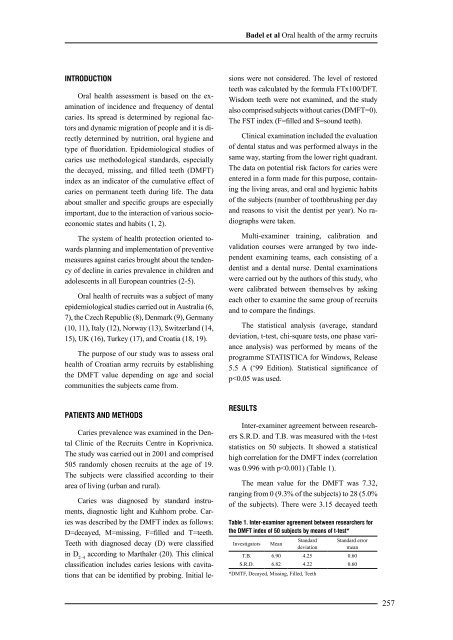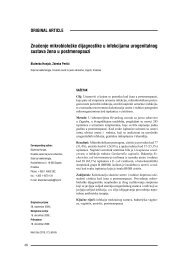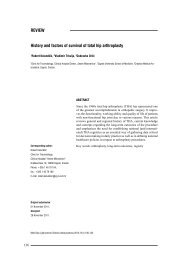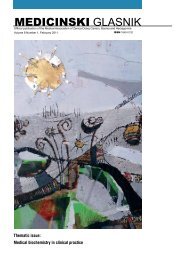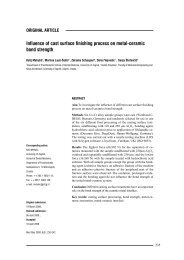MEDICINSKI GLASNIK
MEDICINSKI GLASNIK
MEDICINSKI GLASNIK
You also want an ePaper? Increase the reach of your titles
YUMPU automatically turns print PDFs into web optimized ePapers that Google loves.
INTRODUCTION<br />
Oral health assessment is based on the examination<br />
of incidence and frequency of dental<br />
caries. Its spread is determined by regional factors<br />
and dynamic migration of people and it is directly<br />
determined by nutrition, oral hygiene and<br />
type of fluoridation. Epidemiological studies of<br />
caries use methodological standards, especially<br />
the decayed, missing, and filled teeth (DMFT)<br />
index as an indicator of the cumulative effect of<br />
caries on permanent teeth during life. The data<br />
about smaller and specific groups are especially<br />
important, due to the interaction of various socioeconomic<br />
states and habits (1, 2).<br />
The system of health protection oriented towards<br />
planning and implementation of preventive<br />
measures against caries brought about the tendency<br />
of decline in caries prevalence in children and<br />
adolescents in all European countries (2-5).<br />
Oral health of recruits was a subject of many<br />
epidemiological studies carried out in Australia (6,<br />
7), the Czech Republic (8), Denmark (9), Germany<br />
(10, 11), Italy (12), Norway (13), Switzerland (14,<br />
15), UK (16), Turkey (17), and Croatia (18, 19).<br />
The purpose of our study was to assess oral<br />
health of Croatian army recruits by establishing<br />
the DMFT value depending on age and social<br />
communities the subjects came from.<br />
PATIENTS AND METHODS<br />
Caries prevalence was examined in the Dental<br />
Clinic of the Recruits Centre in Koprivnica.<br />
The study was carried out in 2001 and comprised<br />
505 randomly chosen recruits at the age of 19.<br />
The subjects were classified according to their<br />
area of living (urban and rural).<br />
Caries was diagnosed by standard instruments,<br />
diagnostic light and Kuhhorn probe. Caries<br />
was described by the DMFT index as follows:<br />
D=decayed, M=missing, F=filled and T=teeth.<br />
Teeth with diagnosed decay (D) were classified<br />
in D 2–4 according to Marthaler (20). This clinical<br />
classification includes caries lesions with cavitations<br />
that can be identified by probing. Initial le-<br />
Badel et al Oral health of the army recruits<br />
sions were not considered. The level of restored<br />
teeth was calculated by the formula FTx100/DFT.<br />
Wisdom teeth were not examined, and the study<br />
also comprised subjects without caries (DMFT=0).<br />
The FST index (F=filled and S=sound teeth).<br />
Clinical examination included the evaluation<br />
of dental status and was performed always in the<br />
same way, starting from the lower right quadrant.<br />
The data on potential risk factors for caries were<br />
entered in a form made for this purpose, containing<br />
the living areas, and oral and hygienic habits<br />
of the subjects (number of toothbrushing per day<br />
and reasons to visit the dentist per year). No radiographs<br />
were taken.<br />
Multi-examiner training, calibration and<br />
validation courses were arranged by two independent<br />
examining teams, each consisting of a<br />
dentist and a dental nurse. Dental examinations<br />
were carried out by the authors of this study, who<br />
were calibrated between themselves by asking<br />
each other to examine the same group of recruits<br />
and to compare the findings.<br />
The statistical analysis (average, standard<br />
deviation, t-test, chi-square tests, one phase variance<br />
analysis) was performed by means of the<br />
programme STATISTICA for Windows, Release<br />
5.5 A (‘99 Edition). Statistical significance of<br />
p


